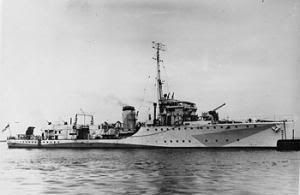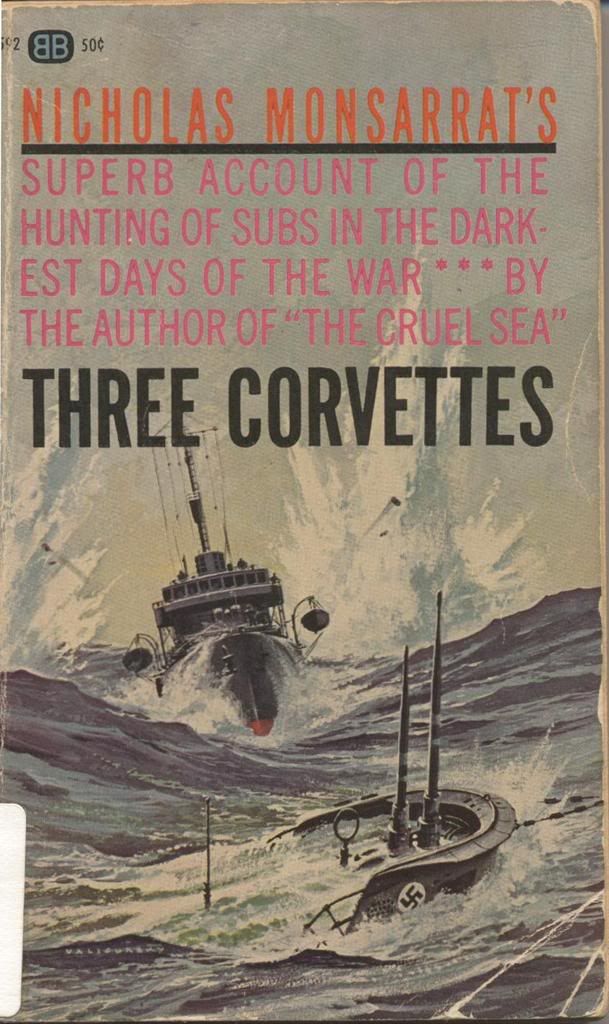Folks,
No updates for the next six weeks or so, I will be shipping out to sea for that time, and will be unable to update. I hope to get one more update done later tonight with my ship, the SSV Corwith Cramer.
Read more!
Sunday, October 12, 2008
Friday, October 3, 2008
HMS Shearwater
I meant to get this post published last night, however the VP debate and commentary thereafter unfortunately took my attention away from this post. This week's ship is a classic World War Two corvette/sloop of war (it may be classified as either depending on one's interpretation), the HMS Shearwater (L39)

Stats from Colledge's Ships of the Royal Navy, which can also be found on the Wikipedia page for this ship:
Launched: 18 April, 1939
Commissioned: 7 September, 1939
Decommissioned: 21 April, 1947
Length: 234 ft
Beam: 26 ft 6 in
Draught: 6 ft 6 in
Displacement: 580 tons
Compliment: 55 enlisted, 5 officers
Speed: 20 kts
Power Plant: 2 X 3600 hp geared steam turbines
Armament: 1 QF 4 Mark V 4'/45 caliber gun mounted forward
4 .50 caliber Vickers machine guns
2 depth charge racks, stern mounted
The HMS Shearwater was the last of the Kingfisher class sloops/corvettes, a class which was designed in the mid 1930's as a limited ocean escort vessel for coastal and short ocean escorts. This and subsequent classes came into heavy use at the onset of World War II, where they were needed for convoy escorts across the Atlantic. Upon completion, the Shearwater was based out of various shipping ports along the southern coast of Britian to operate in concert with other corvettes and destroyers, usually multiple corvettes and a single destroyer as flotilla commander, to escort British shipping out into the Atlantic, providing protection from enemy aircraft and U-Boats. The Shearwater is most notable for being the corvette under the command of nautical themed author Nicholas Monsarrat, his first command, and thought to be the first patrol craft (sloop, corvette, patrol boat, or destoyer) under the command of a RNVR officer.
One item that the Shearwater brings up is her confusion in classification between sloop of war, and corvette. By this time, both classifications were being used to refer to small patrol craft; the aspect of using the rig of the ship to identify it became for the most part extinct with rise of the age of steam. However, British guidelines of the 1930's indicated that all small patrol craft not intended for fleet deployment would be classified as sloops. It wasn't until the explosion of shipbuilding in the Second World War that there became a distinction among these small patrol craft. The most commonly accepted difference is in size and propulsion, the sloops were generally smaller and single screwed, while corvettes were generally larger and carried twin screws. Thus, by this classification, the Shearwater would be a corvette, although such details are largely left to the history books in this day in age. But nonetheless an interesting topic of discussion.
Read more!

Stats from Colledge's Ships of the Royal Navy, which can also be found on the Wikipedia page for this ship:
Launched: 18 April, 1939
Commissioned: 7 September, 1939
Decommissioned: 21 April, 1947
Length: 234 ft
Beam: 26 ft 6 in
Draught: 6 ft 6 in
Displacement: 580 tons
Compliment: 55 enlisted, 5 officers
Speed: 20 kts
Power Plant: 2 X 3600 hp geared steam turbines
Armament: 1 QF 4 Mark V 4'/45 caliber gun mounted forward
4 .50 caliber Vickers machine guns
2 depth charge racks, stern mounted
The HMS Shearwater was the last of the Kingfisher class sloops/corvettes, a class which was designed in the mid 1930's as a limited ocean escort vessel for coastal and short ocean escorts. This and subsequent classes came into heavy use at the onset of World War II, where they were needed for convoy escorts across the Atlantic. Upon completion, the Shearwater was based out of various shipping ports along the southern coast of Britian to operate in concert with other corvettes and destroyers, usually multiple corvettes and a single destroyer as flotilla commander, to escort British shipping out into the Atlantic, providing protection from enemy aircraft and U-Boats. The Shearwater is most notable for being the corvette under the command of nautical themed author Nicholas Monsarrat, his first command, and thought to be the first patrol craft (sloop, corvette, patrol boat, or destoyer) under the command of a RNVR officer.
One item that the Shearwater brings up is her confusion in classification between sloop of war, and corvette. By this time, both classifications were being used to refer to small patrol craft; the aspect of using the rig of the ship to identify it became for the most part extinct with rise of the age of steam. However, British guidelines of the 1930's indicated that all small patrol craft not intended for fleet deployment would be classified as sloops. It wasn't until the explosion of shipbuilding in the Second World War that there became a distinction among these small patrol craft. The most commonly accepted difference is in size and propulsion, the sloops were generally smaller and single screwed, while corvettes were generally larger and carried twin screws. Thus, by this classification, the Shearwater would be a corvette, although such details are largely left to the history books in this day in age. But nonetheless an interesting topic of discussion.
Read more!
Wednesday, October 1, 2008
Review!
These past couple of weeks I have been delving into maritime literature, mostly nonfiction historical works, and I figured I would review some of the best of these works here, given that they all tie into historical ships that I may choose to feature at a later date. The first work here is a wonderful look into patrol craft life in the Atlantic during the Second World War. Three Corvettes, by Nicholas Monsarrat details Monserrat's service on three different Corvettes in the Atlantic. This week's ship, which I hope to have up tomorrow, is one of these corvettes, the HMS Shearwater (L39).

Three Corvettes is an autobiographical work written in the form of a log or journal during the time of Monserrat's service, from 1940 to 1943. It is uniquely written in a manner that avoids any censurship; thus Monserrat does not use actual names for people or vessels. Rather, for his companions he uses a single initial, and ship names are fictional, however they do relate to the actual ships he served on.
Monserrat entered the Royal Navy (RN) from the Royal Navy Volunteer Reserve (RNVR), a civilian component of the RN, his RNVR service was such that he was granted a commission as a junior lieutenant aboard an Atlantic escort Corvette as his first assignment. After performing well at that role he was promoted to the First Lieutenant of a second Corvette before moving to take command of his own ship for his third year in service.
Monserrat writes these three works in a unique observational writing style; as they are for the most part excerpts written during the course of his experiences they contain the flavor of shorter stories compiled into one big picture. Due to, I think, his unfamiliarity coming into the military world from civilian life, Monserrat provides the reader with a unique glimpse into the regimented military life, and conversely, the management of power by those who possess it. He writes of many observations that, to the professional naval officer might seem mundane, daily tasks, but to Monserrat and the reader both, they are new experiences, such as pecilular actions of the ordinary sailors, or the thrill of power whilst standing watch, having 750 tons of fighting men and machine answerable to your every command.
While this book can be hard to find because of it's age (published in 1953), and limited public reputation, it is nonetheless a wonderful read and insight into a little-known aspect of the Battle of the Atlantic in the Second World War.
Read more!

Three Corvettes is an autobiographical work written in the form of a log or journal during the time of Monserrat's service, from 1940 to 1943. It is uniquely written in a manner that avoids any censurship; thus Monserrat does not use actual names for people or vessels. Rather, for his companions he uses a single initial, and ship names are fictional, however they do relate to the actual ships he served on.
Monserrat entered the Royal Navy (RN) from the Royal Navy Volunteer Reserve (RNVR), a civilian component of the RN, his RNVR service was such that he was granted a commission as a junior lieutenant aboard an Atlantic escort Corvette as his first assignment. After performing well at that role he was promoted to the First Lieutenant of a second Corvette before moving to take command of his own ship for his third year in service.
Monserrat writes these three works in a unique observational writing style; as they are for the most part excerpts written during the course of his experiences they contain the flavor of shorter stories compiled into one big picture. Due to, I think, his unfamiliarity coming into the military world from civilian life, Monserrat provides the reader with a unique glimpse into the regimented military life, and conversely, the management of power by those who possess it. He writes of many observations that, to the professional naval officer might seem mundane, daily tasks, but to Monserrat and the reader both, they are new experiences, such as pecilular actions of the ordinary sailors, or the thrill of power whilst standing watch, having 750 tons of fighting men and machine answerable to your every command.
While this book can be hard to find because of it's age (published in 1953), and limited public reputation, it is nonetheless a wonderful read and insight into a little-known aspect of the Battle of the Atlantic in the Second World War.
Read more!
Subscribe to:
Posts (Atom)